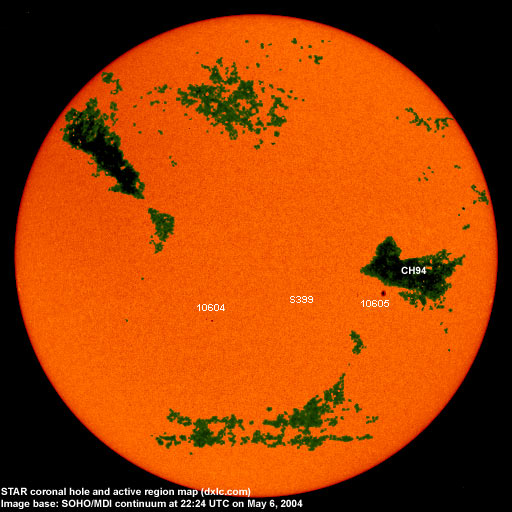

Last major update issued on May 7, 2004 at 04:00 UTC.
[Solar and geomagnetic data - last month (updated daily)]
[Solar wind and electron fluence charts (updated daily)]
[Solar cycles 21-23 (last update May 3, 2004)]
[Solar cycles 1-20]
[Graphical comparison of cycles 21, 22 and 23 (last update May 3, 2004)]
[Graphical comparison of cycles 2, 10, 13, 17, 20 and 23 (last update May 3, 2004)]
[Historical solar and geomagnetic data charts 1954-2004 (last update April 28,
2004)]
[Archived reports (last update April 30, 2004)]
The geomagnetic field was quiet to unsettled on May 6. Solar wind speed ranged between 443 and 621 km/sec under the influence of a fairly benign high speed stream from coronal hole CH94.
Solar flux measured at 20h UTC on 2.8 GHz was 86.4. The planetary A
index was 8 (STAR Ap - based on the mean of three hour interval ap indices: 9.3).
Three hour interval K indices: 22322232 (planetary), 23323322 (Boulder).
The background x-ray flux is at the class A7 level.
At midnight there were 3 spotted regions on the visible disk. The solar flare activity level was very low. No C class events were recorded during the day.
Region 10604 decayed slowly and quietly and could become spotless in a day or two.
Region 10605 decayed significantly losing most of its spots and about half of the penumbral area.
Spotted regions not numbered by NOAA/SEC:
[S399] This region emerged in the southwest quadrant near the central meridian on May 6. There is only one small spot
and the region could soon become spotless again. Location at midnight: S16W12.
May 4-6: No fully or partly Earth directed CME observed.
Coronal hole history (since late October 2002)
Compare today's report with the situation one solar rotation ago: 28
days ago 27 days ago 26 days ago
A trans equatorial coronal hole (CH94) was in a geoeffective position on May 1-4.

Processed SOHO/EIT 284 image at 19:05 UTC on May 6. The darkest areas on the solar disk are likely coronal holes.
The geomagnetic field is expected to be quiet to active on May 7 due to a high speed stream from coronal hole CH94. Mostly quiet is likely on May 8-11.
| Coronal holes (1) | Coronal mass ejections (2) | M and X class flares (3) |
1) Effects from a coronal hole could reach Earth within the next 5 days. When the high speed stream has arrived
the color changes to green.
2) Material from a CME is likely to impact Earth within 96 hours.
3) There is a possibility of either M or X class flares within the next 48 hours.
Green: 0-20% probability, Yellow: 20-60% probability, Red: 60-100% probability.
Long distance low and medium frequency (below 2 MHz) propagation along east-west paths over high and upper middle latitudes is very poor. Propagation along long distance north-south paths is fair. Trans Atlantic propagation conditions are monitored every night on 1470 kHz. Dominant stations tonight: Radio Vibración (Venezuela) and CPN Radio (Perú), both with fairly strong signals. An interesting unidentified Spanish talking station was noted on 1439.87 kHz until Luxembourg on 1440 kHz signed on just before 03h UTC].

Compare to the previous day's image.
Data for all numbered solar regions according to the Solar Region Summary provided by NOAA/SEC. Comments are my own, as is the STAR spot count (spots observed at or inside a few hours before midnight) and data for regions not numbered by SEC or where SEC has observed no spots. SEC active region numbers in the table below and in the active region map above are the historic SEC/USAF numbers.
| Active region | Date numbered | SEC spot count |
STAR spot count |
Location at midnight | Area | Classification | Comment |
|---|---|---|---|---|---|---|---|
| 10604 | 2004.05.03 | 2 | 3 | S19E10 | 0030 | DSO |
classification was HSX at midnight, area 0020 (negative polarity spots) |
| 10605 | 2004.05.04 | 8 | 4 | S11W30 | 0070 | DSO |
classification was CSO at midnight |
| S399 | emerged on 2004.05.06 |
1 | S16W12 | 0000 | AXX | ||
| Total spot count: | 10 | 8 | |||||
| SSN: | 30 | 38 | |||||
| Month | Average solar flux at Earth |
International sunspot number | Smoothed sunspot number |
|---|---|---|---|
| 2000.04 | 184.2 | 125.5 | 120.8 cycle 23 sunspot max. |
| 2000.07 | 202.3 | 170.1 | 119.8 |
| 2001.12 | 235.1 | 132.2 | 114.6 (-0.9) |
| 2003.04 | 126.4 | 60.0 | 70.1 (-3.9) |
| 2003.05 | 115.7 | 55.2 | 67.6 (-2.5) |
| 2003.06 | 129.3 | 77.4 | 65.0 (-2.6) |
| 2003.07 | 127.7 | 83.3 | 61.8 (-3.2) |
| 2003.08 | 122.1 | 72.7 | 60.0 (-1.8) |
| 2003.09 | 112.2 | 48.7 | 59.5 (-0.5) |
| 2003.10 | 151.7 | 65.5 | 58.1 (-1.4) |
| 2003.11 | 140.8 | 67.3 | (56.5 predicted, -1.6) |
| 2003.12 | 114.9 | 46.5 | (53.5 predicted, -3.0) |
| 2004.01 | 114.1 | 37.2 | (49.1 predicted, -4.4) |
| 2004.02 | 107.0 | 46.0 | (44.8 predicted, -4.3) |
| 2004.03 | 112.0 | 48.9 | (42.1 predicted, -2.7) |
| 2004.04 | 101.2 | 39.3 | (40.0 predicted, -2.1) |
| 2004.05 | 90.9 (1) | 9.5 (2) | (36.8 predicted, -3.2) |
1) Running average based on the daily 20:00 UTC observed solar flux value at 2800 MHz.
2) Unofficial, accumulated value based on the Boulder (NOAA/SEC) sunspot number. The official international sunspot number is typically
30-50% less.
This report has been prepared by Jan Alvestad. It is based partly on my own observations and analysis, and partly on data from some of these solar data sources. All time references are to the UTC day. Comments and suggestions are always welcome.
| [DX-Listeners' Club] |